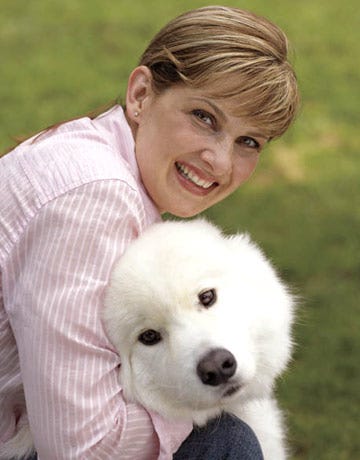My Dog Is Shivering and Trying to Bite Her Back Leg

Photo by Chris Cbur
My eight-month-old puppy loves my five-year-old son. Usually, he smiles and talks when we pet him while he's eating, but yesterday he bit my son. Why did he suddenly turn on us?
When I hear the description of your dog's behavior, it sounds like someone who parked his car in the middle of the railroad tracks, even though the gates were going down and the train horn was blowing. All the warning signs were there, they just weren't heeded. You think your dog's behavior is the canine version of human talking and smiling, but you're wrong.
Anthropomorphizing dog behavior is one of the biggest reasons people find themselves bitten. Actually, your dog has been clearly signaling that he feels dominant and controlling toward you. Growling and lifting his lip are his way of warning you to stay away from his food.
My first question to you is: Have you neutered your dog? If not, it's something to strongly consider. Neutering a puppy who is becoming increasingly aggressive will reduce, but not eliminate, owner-directed aggression.
Next, young children should never be allowed to spend time alone with a dog. Period. I don't care if you have the best dog and child in the world, things happen. Of the estimated 4.7 million dog bites that occur each year, the highest incidences involve boys five to nine years of age. Well-behaved, wonderful children have made the mistake of hugging a dog around the neck, of trying to take a toy away, or trying to pet a dog while it was eating and some have paid dearly for it.
What triggers one dog may not trigger another, which is why children don't understand why Grandma's dog loves a hug, but other dogs may not. Your job is to monitor the interactions of your child and your dog, and try to translate what the dog is "saying" when he pins his ears back, or lowers his head and looks away: he's on alert. Teach your child that things he does, like racing around the house and yelling, can kick in an instinct called prey drive in your dog, resulting in him being chased, herded, jumped on, or even nipped. Even if your doorbell rings and you need to leave the room for a second, take the dog, your child, or both, along with you to answer the door.
Remember, it's not just your child who needs training, but the dog, too. Ask your vet for a referral to a qualified trainer/behaviorist who can correctly diagnose the problem and help you work through it, preferably including your child in the training sessions. In my classes we help the children to teach the dogs "sit," and then progress to more complex commands. By doing this, your dog will learn that he must respect your child instead of tolerating him. Happily, from respect will grow the friendship you intended when you first made the decision to bring a dog into your home.
Canine Conversation
To teach yourself (and your child) what your dog is trying to say, there's no better place to start than with Brenda Aloff's amazing book, Canine Body Language: A Photographic Guide Interpreting the Native Language of the Domestic Dog. Although no book is a complete substitute for working with a qualified trainer, especially when aggression or other serious issues arise, this book is a must-read for everyone who owns (or is owned by!) a dog. ($40; 800-776-2665; dogwise.com)
Trainer and behaviorist Kathy Santo is the author of Kathy Santo's Dog Sense (Knopf). Send questions to Kathyforhb@hearst.com.
This content is created and maintained by a third party, and imported onto this page to help users provide their email addresses. You may be able to find more information about this and similar content at piano.io
My Dog Is Shivering and Trying to Bite Her Back Leg
Source: https://www.housebeautiful.com/lifestyle/kids-pets/q-and-a/a44/dog-shrink-behavior-0907/